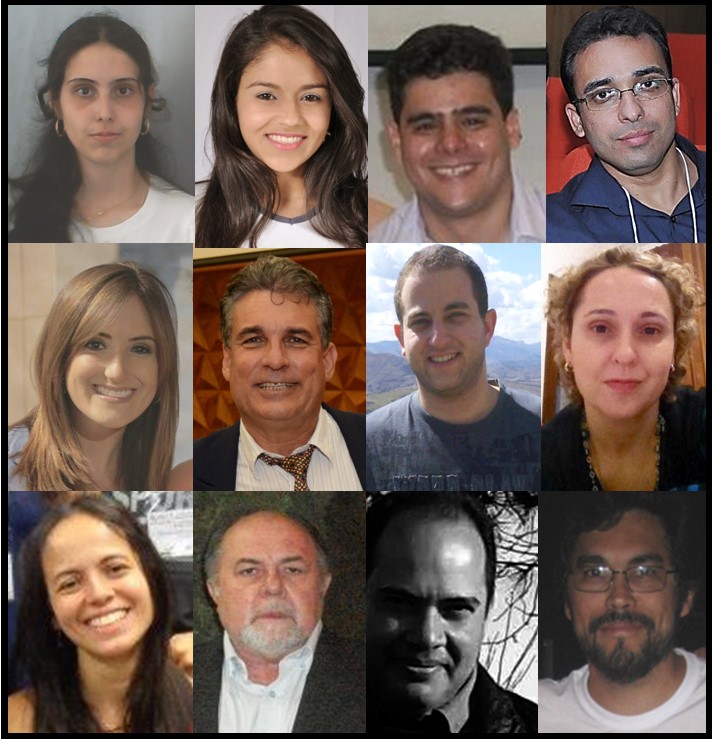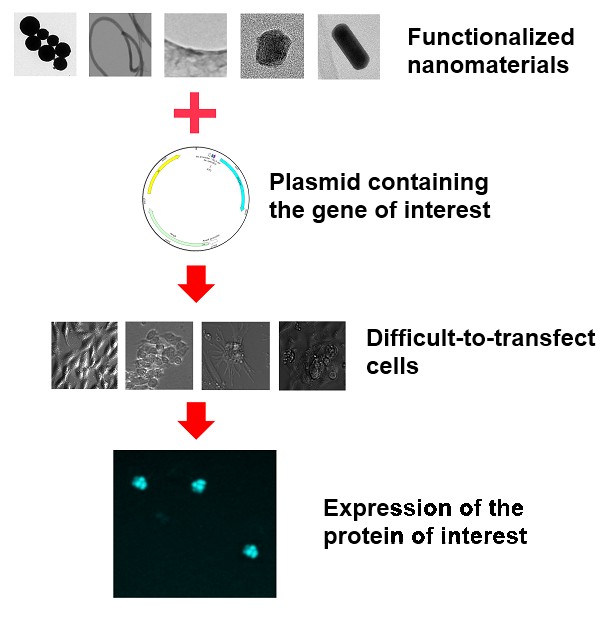[Paper: Functionalized nanomaterials: are they effective to perform gene delivery to difficult-to-transfect cells with no cytotoxicity? Tonelli, F.M.P. ; Lacerda, S. M. S. N.; Paiva, N. C. O.; Pacheco, F. G.; Scalzo Junior, S. R. A.; de Macedo, F. H. P.; Cruz, J. S.; Pinto, M. C. X.; Correa Junior, J. D.; Ladeira, L. O.; França, L. R.; Guatimosim, S.; Resende, R. R. Nanoscale, 2015,7, 18036-18043. DOI: 10.1039/C5NR04173B]
Nanomaterials may be useful in processes in which one introduces genes (DNA segments) into particular cells in a controlled manner. These processes are called transfections and can be aimed at curing diseases caused by the lack of a certain gene (gene therapy) or obtaining transgenic organisms, to name but a few examples.
In a study conducted in Brazil by a multidisciplinary team, it was tested the efficiency of several nanomaterials in delivering genes into different types of rat and human cells, all considered difficult to be transfected (hard-to-transfect cells).
The study findings were recently published as a communication on the scientific journal Nanoscale and were the subject of patent applications to INPI (Brazilian Patent and Trademark Office).
The research, which was conducted in only six months, counting from the project design to the submission of the article, involved the work of thirteen scientists from the Universidade Federal de Minas Gerais (UFMG), who were organized into a research network in nanobiotechnology initiated in partnership with FAPEMIG (Minas Gerais state research foundation). “The multidisciplinary approach of the group was instrumental in carrying out the work in a short period of time and in order for it to be accepted for publication in Nanoscale”, says Rodrigo Resende, a professor in the UFMG’s Department of Biochemistry and Immunology, and corresponding author of the article published on Nanoscale.

The idea that led to the research came from Fernanda Maria Policarpo Tonelli’s research thesis, conducted with Resende’s supervision in order to obtain her master’s degree in Biochemistry and Immunology. “The work involved spermatogonial stem cells from tilapias (primary culture), which are hard-to-transfect”, says the professor. “In trying to deliver genes of interest to these cells, we noticed that this was a difficult task”, he says. Once the student realized that the use of functionalized multi-walled carbon nanotubes made the process easier, it came up the idea of systematically checking the ability of a series of functionalized nanomaterials to deliver genes to hard-to-transfect cells.
Indeed, nanomaterials are interesting candidates to be gene delivery vehicles, not only by the variety of sizes, shapes and properties that can be obtained by the functionalization and the numerous methods of synthesis, but also because they provide high protection to the gene that they must deliver. “They prevent the deterioration of the nucleic acid during the extra and intracellular trafficking”, says Resende. “In addition, among the nanomaterials, the gold nanorods also provide a very useful feature to the gene delivery: the possibility of photothermal release; i.e., the release of genes can be induced to the nanocomplex with exposure to light at the proper wavelength”, adds the professor.
To conduct the experimental research that led to the article on Nanoscale, Resende and his colleagues manufactured some nanomaterials. Carbon nanotubes, gold nanorods, nanodiamonds and nano-graphene oxide were synthesized at the Nanomaterials Laboratory of the UFMG´s Institute of Exact Sciences and the UFMG´s Cell Signaling and Nanobiotechnology Laboratory, while phosphate nanocomposites were manufactured at the Laboratory of Chemical-Biological Interactions and Animal Reproduction of the Department of Morphology of said university.
Following the above mentioned, all nanomaterials were functionalized; i.e., groups of atoms were added to their surfaces so as to achieve specific chemical properties in the materials. This part of the research and almost all of the subsequent experiments were conducted at the Cell Signaling and Nanobiotechnology Laboratory of the Department of Biochemistry and Immunology and the Cell Biology Laboratory of the Department of Morphology, also at UFMG. The actual functionalization of the nanomaterials was confirmed by Fourier-Transform Near-Infrared (FT-NIR) spectroscopic analyzes, conducted at the Nuclear Technology Development Center, located in the UFMG’s campus. Thanks to the functionalization, the nanomaterials stuck to the DNA containing the gene of interest, forming nanocomplexes.
Then, the scientists exposed to the nanocomplexes the rat and human cells, obtained at laboratories of the UFMG’s departments of Physiology and Pharmacology and of Biochemistry and Immunology.
Finally, the researchers observed, for each material and for each type of cell studied, whether the gene of interest had entered the cell and was conducting its functions at the new address.

The results published on Nanoscale show that, in general, the nanomaterials are good vehicles for delivering genes to hard-to-transfect cells, equaling or surpassing, in some cases, the capacity of commercially available reagents. Fact: the synthesis of the nanomaterials costs less than the purchase of some reagents.
In addition, the authors of the communication checked the cytotoxicity of each nanomaterial for each cell studied and were able to determine the relevant cell death rates. The scientists concluded that, in proper concentrations, the nanomaterials studied have low cytotoxicity.
These UFMG team’s findings can now be applied to researches involving gene delivery. “For example, if one wishes to study the function of a particular protein in cardiomyocytes and it is necessary to express this protein in these cells, using functionalized multi-walled carbon nanotubes is more efficient than the lipofection with the Lipofectamine 2000 commercial reagent”, illustrates the Resende.
“As for the slightly more distant applications, it is also a possibility to adapt the methodology aiming at the feasibility of gene therapy and transgenesis mediated by nanomaterials”, continues Resende, who says that his research group is already conducting further studies in vitro and in vivo to develop such applications.
According to Resende, another consequence of the article may arise given the difference in behavior observed in the different cells for different nanomaterials. “This offers the possibility of developing studies on how the delivered genes are internalized by each cell and for what reason there are differences in efficiency observed in our study”, says the professor.
The research was funded by Brazlian agenciesCNPq and APEMIG, the National Institute of Science and Technology in Carbon Nanomaterial and the Nanocell Institute, an independent organization founded by the Professor Rodrigo Resende’s research group, for the promotion of science and education.
